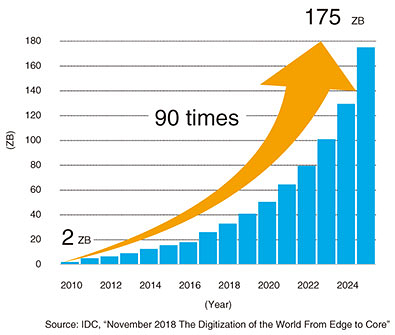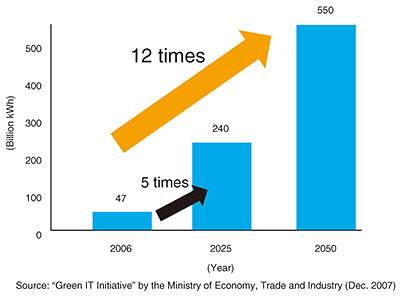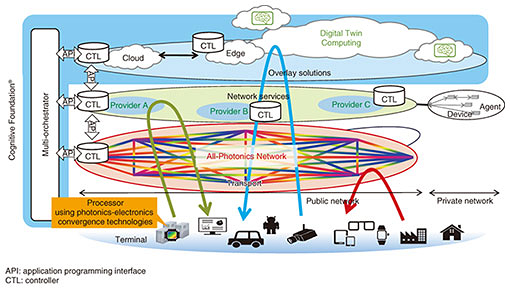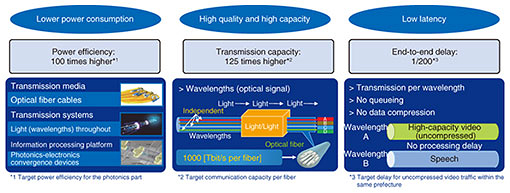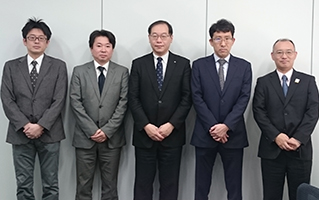 |
|||||||
|
|
|||||||
|
IOWN (Innovative Optical and Wireless Network) Vol. 18, No. 2, pp. 27–31, Feb. 2020. https://doi.org/10.53829/ntr202002iw1 Initiatives to Achieve the IOWN (Innovative Optical and Wireless Network) ConceptAbstractNTT proposed the IOWN ( Keywords: IOWN, All-Photonics Network, Digital Twin Computing, Cognitive Foundation 1. Toward a new worldImportant innovations, such as the Internet and smartphones, have changed our society dramatically. As a result, people’s values have also been affected such as from ownership to usership. As computerization and informatization in our society accelerates, the use of artificial intelligence (AI) and Internet of Things (IoT) will increase, such as for new financial services with ICT (information and communication technology) and automated driving through AI. It is conceivable that our lives will change drastically and that diverse values will emerge [1]. 1.1 Responding to diversityWhat makes this new world diverse is the understanding of others. To deepen such understanding, it is very helpful to see information and sensibilities from the perspective of others. To build this world through technology, it is necessary not only to obtain more information by developing high-definition and highly sensitive sensors but also to process information by taking into account the sensibility and subjectivity of others. It is necessary to incorporate not only science and technology but also the humanities and social sciences. We use the term natural for the condition that arises when humans enjoy the results of technology without stress. We also use the term natural harmonic for a world where people and the environment are in harmony. These will be our objectives. 1.2 Transcending the limits of the InternetIn such a world, transmitting and processing a huge amount of information is required, and current information and communication systems cannot handle such information. It is estimated that the amount of Internet traffic in Japan will increase 190 fold from 2006 to 2026 (From 637 Gbit/s to 121 Tbit/s) and global data volume will increase 5.3 fold in just 7 years (33 ZB in 2018 to 175 ZB in 2025) (Fig. 1).
If we try to mitigate such a situation using only current information communication systems, we will face serious problems such as further increase in communication volume, further complication of networks, and increase in delay due to congestion. 1.3 Overcoming increases in power consumptionThe explosive increase in the number of connected devices due to advances in IoT not only increases network load but also raises serious concerns about energy consumption (Fig. 2). The increase in power consumption of datacenters, which are essential for providing cloud services, has become a global problem.
We are now facing the density limit of integrated circuits. The degree of integration has been reduced to nanometers, and manufacturing is running up against physical limits. As power consumption increases, the temperature increase in integrated circuits due to an increase in the rate of heat dissipation is becoming evident, and the limit of processor clock frequency is starting to be noticed. 2. Innovative Optical and Wireless Network (IOWN)To create an affluent and diverse society, NTT has proposed the Innovative Optical and Wireless Network (IOWN) concept, which is a new communication infrastructure that can provide high-speed broadband communication and enormous computing resources by using innovative technologies including optical technologies. NTT also believes that these innovative technologies can optimize society as a whole and individuals using all types of information. IOWN uses three elements, All-Photonics Network, Digital Twin Computing, and Cognitive Foundation® to create a smart world, as shown below (Fig. 3).
2.1 All-Photonics NetworkAs the number of people and things connected to a network increase, advanced, complex, and large-scale information processing such as for AI will require a vast amount of power consumption. To reduce such power consumption and meet mission critical service requirements, NTT applies photonics technologies to end-to-end environments for achieving ultra-low-power consumption, large-capacity, and low-delay networks. For example, NTT aims to increase power efficiency 100 fold by developing transmission devices that control optical wavelengths and photonics-electronics convergence devices. NTT also aims to expand transmission capacity 125 fold by increasing multiplexing in optical fibers and expanding multicores in a fiber (Fig. 4).
2.2 Digital Twin ComputingA digital twin is an image of real-world objects, such as production machines, aircraft engines, and automobiles in factories, by mapping their shapes, conditions, and functions into cyberspace and expressing them accurately. Using digital twins enables us to analyze the current situation, predict the future, and simulate objects in cyberspace. Digital Twin Computing is a new computing paradigm that makes it possible to reproduce and simulate the interaction between things and people freely in cyberspace by conducting computations such as exchange, fusion, duplication, and synthesis for many digital twins representing the real world [2]. 2.3 Cognitive Foundation®To achieve low-power-consumption, high-capacity, high-quality communication networks and large-scale interactions between people and objects, it is necessary to select and use various resources appropriately. The Cognitive Foundation is an infrastructure that provides a set of functions necessary to build and operate services by using various methods of collecting, processing, storing, and communicating data scattered throughout various locations. 3. Establishment of IOWN Global ForumTo enable IOWN, it is necessary not only to create and combine many innovative technologies but also promote these technologies for widespread use. Major changes in information processing, communication, and network infrastructure are required, and extensive knowledge and insight is needed. NTT Group alone cannot achieve this. Accordingly, NTT, Intel, and Sony established the IOWN Global Forum to achieve IOWN, and will invite partners with a wide range of knowledge and insight from various industries [3]. The purpose of this forum is to promote IOWN by creating and publishing specifications, frameworks, and reference architectures of new technologies in the following fields.
In the future, NTT, Intel, and Sony will select initial board members to jointly operate the forum, establish a working group, and work with a wide range of partners to achieve IOWN. We introduced NTT’s activities to enable the IOWN concept and the efforts of the IOWN Global Forum, in which various partners will collaborate. We will create a new smart world by combining innovative technologies cultivated by NTT laboratories with technologies and knowledge from various partners. References
Trademark notesAll brand, product, and company/organization names that appear in this article are trademarks or registered trademarks of their respective owners.
Authors (from left): Kunihiko Minamihata, manager, R&D Vision Group, NTT Research and Development Planning Department; Katsushi Shindo, manager, R&D Vision Group, NTT Research and Development Planning Department; Shigeru Iwashina, senior manager, R&D Vision Group, NTT Research and Development Planning Department; Masakatsu Fujiwara, VP and general manager, NTT Network Technology Laboratories; and Yosuke Aragane, senior manager, R&D Vision Group, NTT Research and Development Planning Department |
|||||||









